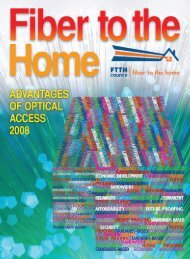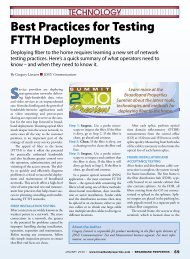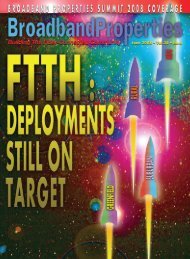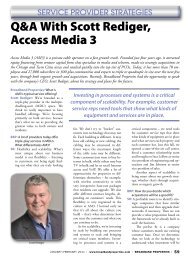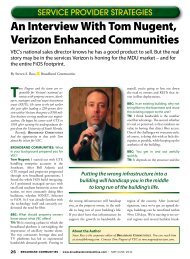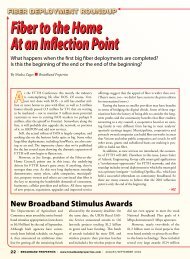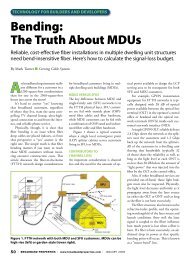2010 Buyers Guide - Broadband Properties
2010 Buyers Guide - Broadband Properties
2010 Buyers Guide - Broadband Properties
Create successful ePaper yourself
Turn your PDF publications into a flip-book with our unique Google optimized e-Paper software.
Wallsten, economics director of the<br />
adoption group for the FCC’s Omnibus<br />
<strong>Broadband</strong> Initiative, said that to<br />
achieve gains in productivity and in<br />
adoption of information technology by<br />
various business sectors, “you need a<br />
mix of infrastructure and organizational<br />
investments.” That is, one cannot simply<br />
budget for fiber and hope for the best.<br />
Hudson noted that, even in the<br />
United States, telemedicine has not always<br />
been sustainable because insurance<br />
companies would not pay for remote<br />
consultations; Medicare does reimburse<br />
such consultations now.<br />
“The government has tradeoffs [in<br />
spending limited funds] and thus cannot<br />
[afford to] make mistakes,” Wallsten<br />
said. He added that the government<br />
would try to increase wireless spectrum<br />
either by allocating more or by making<br />
secondary markets work better. (There<br />
are opportunities for increasing the<br />
amount of spectrum that changes hands<br />
in third-party transactions.) Wallsten<br />
also admitted that the Universal Service<br />
Fund, which is intended to make<br />
telecommunications affordable for lowincome<br />
and rural residents, “is not sustainable<br />
at all – it is voice-only and is<br />
a high tax, [yet there is] a large digital<br />
divide and the biggest gap is by income.”<br />
This tax is counterproductive, he said.<br />
The FCC is scheduled to issue a new<br />
universal service funding plan in February,<br />
but despite prodding from Noam,<br />
Wallsten would not offer details. He said<br />
only that separate groups are working on<br />
the smart grid, telemedicine, broadband<br />
adoption rates and so forth.<br />
Matthias Kurth, president of Germany’s<br />
Federal Network Agency<br />
(roughly equivalent to the chairman of<br />
the FCC in the United States), said that,<br />
in his country, “the goal is 1 Mbps universal<br />
service” with a “second step [to]<br />
50 Mbps by 2014.” But, he noted, the<br />
economic pathway to that goal, even at<br />
this late date, is not well marked.<br />
Said Kurth, “Norway has great<br />
[broadband] penetration but the usage<br />
is poor. We believe we should not kill<br />
the private sector; there is necessity for<br />
public investment, but only in [rural]<br />
areas that cannot have competitive private<br />
investment.” Kurth also notes that<br />
in Germany, as in much of Europe, governments<br />
strive to be neutral between<br />
fixed and wireless options. “We cannot<br />
predict where [fixed/mobile convergence]<br />
is going,” he said, adding that the<br />
economic impact of different broadband<br />
technologies was also hard to predict,<br />
except in broad generalities.<br />
UK REACHES ACROSS DIVIDE<br />
Derek Wyatt, a member of the British<br />
Parliament and co-chair of its All Party<br />
Communications Group, asked, “What<br />
are we going to do about the 30 percent<br />
[in the U.K.] who have not taken<br />
up broadband?” Wyatt said he expected<br />
Parliament to enact a commitment to<br />
achieving universal 2 Mbps broadband<br />
by 2012. He called that “rather low<br />
and rather late,” citing a new PricewaterhouseCoopers<br />
(PwC) study for a<br />
government-funded nonprofit organization,<br />
Digital Inclusion, whose mission is<br />
reducing the digital divide in the U.K.<br />
(The full report is online at www.raceonline2012.org.).<br />
PwC estimated the<br />
economic benefit of getting everyone in<br />
the U.K. online at as much as £22 billion<br />
(close to $40 billion).<br />
PwC estimated that more than 10<br />
million adults in the U.K. have never<br />
used the Internet – and that 4 million<br />
of that group are “socially excluded,”<br />
that is, not working. Of these 4 million<br />
adults, 39 percent are over 65 years old,<br />
38 percent are able to be in the workforce<br />
but are unemployed and 19 percent<br />
are in families with children. PwC<br />
NTIA Administrator Says<br />
Government Has <strong>Broadband</strong> Role<br />
National Telecommunications and Information Administration (NTIA) Administrator<br />
Lawrence Strickling reported on the status of broadband planning efforts in<br />
the United States, citing “the importance of broadband to our economic development;<br />
the commitment of the [Obama] administration to Internet assurance [access<br />
to the Internet]; and the role of telecommunications in creating a transparent<br />
and connected government.”<br />
The current economic crisis, he said, “has led to cutbacks in innovation, counteracted<br />
by the stimulus package.”<br />
The situation requires more than funds for deployment, he said. NTIA also seeks<br />
to “promote building blocks of innovation [with the] largest increase in R&D, new<br />
infrastructure, education [and an] advanced technology ecosystem that includes<br />
providing all Americans with access to broadband.” He added that the broadband<br />
access mapping effort had not attracted a lot of interest, although four grants (for<br />
mapping in California, Indiana, North Carolina and Vermont) had been awarded.<br />
Strickling noted the “last mile/middle mile tension” among grant applications<br />
for the first round of stimulus funds. “If we focus public dollars on the middle mile,<br />
how certain are we that last-mile providers will materialize? What about connecting<br />
anchor institutions like schools and libraries?<br />
“We’re trying to avoid funding bad projects. ... [We’re looking for a] comprehensive<br />
community approach to fund public/private partnerships, anchors, commitments<br />
to engage end-user services, [and ways to] provide lessons for other<br />
projects down the road.<br />
“On the adoption side we have $250 million at least. These are one-time deals,<br />
not a subsidy program. Can we spend a dollar once and get people to adopt?” He<br />
cited the latest Pew Research Center surveys suggesting that this strategy can work;<br />
Pew found that half the people not adopting are unfamiliar with the technology.<br />
Strickling admitted that the need to get money out quickly has somewhat<br />
trumped the desire to coordinate funding to address various national needs. “We<br />
joined the USDA [rural] and NTIA [urban, underserved] programs, and are also<br />
working with others like health [programs] – but the programs are different,” he<br />
said. “The health folks have not picked their communities and seem to be on a later<br />
schedule than us.” The Department of Energy, on the other hand, handed out its<br />
smart-grid grants before the broadband funding started.<br />
56 | BROADBAND PROPERTIES | www.broadbandproperties.com | November/December 2009



